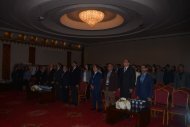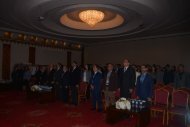Gerçek Yaşamda Karaciğer ve İnflamatuar Barsak Hastalıkları Sempozyumu
Kongre Bildiri özetleri
Kongre Bildiri özetleri
You also want an ePaper? Increase the reach of your titles
YUMPU automatically turns print PDFs into web optimized ePapers that Google loves.
SS38 (P2)<br />
Can Budesonide be a new standard of remission maintenance therapy for<br />
non-cirrhotic patients with AIH?<br />
Fehmi Ates 1 , Serkan Yaras 1 , Osman Ozdogan 1 , En<strong>ve</strong>r Ucbilek 1 , Engin Altintas 1 , Orhan Sezgin 1<br />
1<br />
Mersin Üni<strong>ve</strong>rsitesi Tıp Fakültesi Gastroenteroloji Bilim Dalı<br />
BACKGROUND & AIMS: The initial treatment of choice for autoimmune hepatitis (AIH) is prednisone<br />
alone or with azathioprine. A significant number of patients with AIH de<strong>ve</strong>lop steroid-specific side effects<br />
or require doses of steroids that are unacceptable for long-term treatment. We in<strong>ve</strong>stigated the efficacy<br />
and safety of budesonide as an alternati<strong>ve</strong> steroid maintenance therapy for patients which were previously<br />
treated with prednisolone remission induction therapy.<br />
METHODS: We performed a retrospecti<strong>ve</strong> analysis of data from 36 patients (30 female) with non-cirrhotic<br />
AIH who were treated initially with prednisolone but then switched to budesonide, conducted at two<br />
centers in Turkey from 2009 through No<strong>ve</strong>mber 2017. Patients were evaluated after 6 months, 12 months,<br />
24 months, 36 months, and at the last follow-up evaluation; response to treatment with budesonide was<br />
assessed based on normal serum le<strong>ve</strong>ls of aminotransferases and IgG (biochemical response).<br />
RESULTS: Twenty patients were switched to budesonide therapy because of prednisolone-induced side<br />
effects and 16 patients were switched because of prednisolone dependency. Completely, a biochemical<br />
response was detected in 58% of patients after 6 months of budesonide treatment, in 75% after 12 months,<br />
and in 72% after 24 months. At the last follow-up evaluation (mean time, 60 mo) 12 patients (33%) were still<br />
receiving budesonide treatment. Six patients (17%) had stopped budesonide therapy because of insufficient<br />
response to budesonide or its side effects. Nine patients with osteopenia at the beginning of budesonide<br />
treatment were followed up and evaluated by dual-energy X-ray absorptiometry. After a median of 24<br />
months of budesonide treatment, bone mineral density had impro<strong>ve</strong>d in 5 patients, remained stable in 4<br />
patients.<br />
CONCLUSIONS: Oral budesonide, in combination with azathioprine, can effecti<strong>ve</strong>ly maintain remission<br />
in patients with non-cirrhotic AIH, with a low rate of steroid-specific side effects. The combination of<br />
budesonide with azathioprine may therefore become a new standard of remission maintenance therapy for<br />
non-cirrhotic patients with AIH.<br />
66





